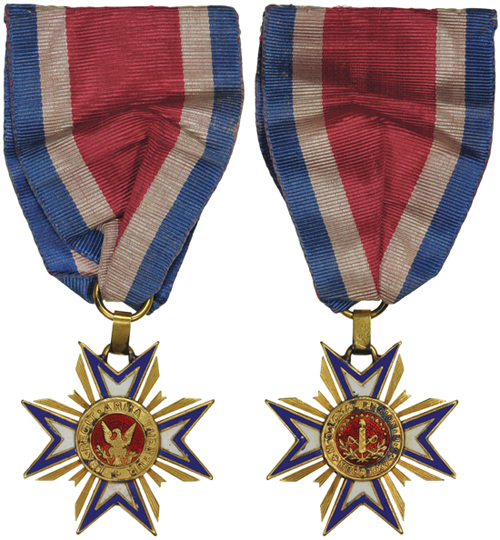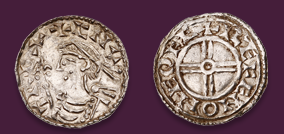
Auction: 314 - Numismatic Collector's Series Sale
Lot: 1072
1865 George Armstrong Custer´s Personal Military Order of the Loyal Legion of the United States Badge. 5.5gms - gold, enamel and ribbon. 31mm across/31mm high/4mm thick. By: Unknown maker. Obv: American eagle at center with olive branch in left talon and arrows in right, red enamel surrounding with underlying pebbling; surrounded by outer circle that reads - LEX REGIT (law rules) / ARMA TUENTUR (arms defend); outer cross formed by gold inlaid with inner white enamel and outer blue enamel; three golden rays reside in the angles. Rev: Capped fasces at center with crossed swords below that intersect a half wreath, 13 stars above, red enamel surrounds as on obverse; outer golden ring reads - M - O - LOYAL LEGION U.S. / MDCCCLXV; outer cross as obverse. Loop: Hand Engraved - 1641. Ribbon: Tri-colored silk with broad 17mm center red stripe and thinner 4mm outer white and blue stripes.Founded directly following the Confederate surrender in April of 1865 and the assassination of President Lincoln shortly thereafter, by-laws and a constitution were drafted to form the Military Order of Loyal Legions of the United States. Much like the Society of the Cincinnati that was formed after the American Revolution, the Military Order of the Loyal Legion of the United States (MOLLUS) was formed as a veteran society largely founded to help promote patriotism, to strengthen bonds, to promote the military sciences, to relieve veterans in need and support current military membership. Perhaps unspoken of this society was a military-like structure that would return veterans to duty if crisis (as appeared possible) were to arise. Military membership was vast and included Ulysses S. Grant, William T. Sherman, George B. McClellan, Winfield Scott, George Meade, Philip Sheridan, David Farragut and of course George Armstrong Custer. Ceremonial invitees include six Presidents: Hayes, Arthur, Grant, Harrison and McKinley as well as notable civilians: Salmon P. Chase, William H. Seward and Edwin Staton. The organization remains in existence today and is composed of four tiers - Hereditary, Junior, Associate and Honorary.Legion members, including George Custer, were each given certificates of membership as well as badges that carried unique membership numbers. As documented in "Union Blue" by Robert G. Carroon and Dana B. Shoaf, Custer was given number 1641 - matching the present badge and confirming his one-time ownership.The badge is set in highly alloyed gold with areas of surrounding blue, white, and red enamel. Because of the copper alloying, several toning spots are noted, particularly around the legends and loop. The enameling is original and complete. The ribbon shows small age toning, but is unfrayed and original. Overall, a superbly preserved piece.The importance behind the reappearance of such a personal relic after nearly a century and a half in hiding cannot be underestimated. Very few items, especially those in public hands, can be traced so closely to Custer´s personal ownership. Further, very few medals or decorations of any kind are known to exist, including his favorite "Custer" medal that he is often seen wearing in period photographs. That leaves the present medal as one of Custers´ most important military artifacts - a museum piece to say the least.
Sold for
$35,000




